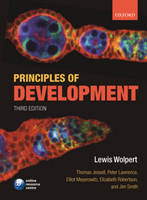
Principles of Development
Seiten
2006
|
3rd Revised edition
Oxford University Press (Verlag)
978-0-19-927536-6 (ISBN)
Oxford University Press (Verlag)
978-0-19-927536-6 (ISBN)
- Titel erscheint in neuer Auflage
- Artikel merken
Reveals the universal principles, which govern the process of development. This book focuses on those systems that illuminate common principles, explaining the complex yet intricate processes through which biological development occurs. It is useful for students encountering this subject for the first time, and for the duration of their studies.
The process of biological development is an amazing feat of tightly-regulated cellular growth and patterning, powerful enough to result in the emergence of a highly-complex living organism from just a single fertilized egg. But how does biological development occur? How can a single fertilized egg give rise to the limbs, organs, and other tissues that comprise a living organism? Principles of Development reveals the universal principles which govern the process of development. Written by one of the most influential developmental biologists of our time, Lewis Wolpert, it focuses on those systems that best illuminate common principles, demystifying the complex yet intricate processes through which biological development occurs. With co-authors whose expertise span the discipline, Principles of Development combines a careful exposition of the subject with insights from some of the world's pioneering developmental biology researchers, taking the student from the fundamentals through to latest discoveries in the field.Assuming no prior knowledge of the subject, and delivered in the lucid, engaging style for which Wolpert is renowned, Principles of Development is an invaluable resource for all students encountering this fascinating subject for the first time, and for the duration of their studies.
Online resource centre: Lecturer resources: Illustrations from the book available to download, to facilitate lecture preparation. Student resources: Multiple choice questions for students to check their understanding. Concept questions for students to explore their understanding of the key principles. Web links to further information resources (including web-based exercises) to encourage independent learning.
The process of biological development is an amazing feat of tightly-regulated cellular growth and patterning, powerful enough to result in the emergence of a highly-complex living organism from just a single fertilized egg. But how does biological development occur? How can a single fertilized egg give rise to the limbs, organs, and other tissues that comprise a living organism? Principles of Development reveals the universal principles which govern the process of development. Written by one of the most influential developmental biologists of our time, Lewis Wolpert, it focuses on those systems that best illuminate common principles, demystifying the complex yet intricate processes through which biological development occurs. With co-authors whose expertise span the discipline, Principles of Development combines a careful exposition of the subject with insights from some of the world's pioneering developmental biology researchers, taking the student from the fundamentals through to latest discoveries in the field.Assuming no prior knowledge of the subject, and delivered in the lucid, engaging style for which Wolpert is renowned, Principles of Development is an invaluable resource for all students encountering this fascinating subject for the first time, and for the duration of their studies.
Online resource centre: Lecturer resources: Illustrations from the book available to download, to facilitate lecture preparation. Student resources: Multiple choice questions for students to check their understanding. Concept questions for students to explore their understanding of the key principles. Web links to further information resources (including web-based exercises) to encourage independent learning.
1. History and basic concepts; 2. Development of the Drosophila body plan; 3. Patterning the vertebrate body plan I: axes and germ layers; 4. Patterning the vertebrate body plan II: the somites and early nervous system; 5. Development of nematodes, sea urchins, ascidians, and slime molds; 6. Plant development; 7. Morphogenesis: change in form in the early embryo; 8. Cell differentiation and stem cells; 9. Organogenesis; 10. Development of the nervous system; 11. Germ cells, fertilization and sex; 12. Growth and post-embryonic development; 13. Regeneration; 14. Evolution and development; GLOSSARY
| Erscheint lt. Verlag | 3.8.2006 |
|---|---|
| Zusatzinfo | 650 figures, colour and halftone illustrations |
| Verlagsort | Oxford |
| Sprache | englisch |
| Maße | 204 x 268 mm |
| Gewicht | 1431 g |
| Themenwelt | Naturwissenschaften ► Biologie ► Allgemeines / Lexika |
| Naturwissenschaften ► Biologie ► Genetik / Molekularbiologie | |
| ISBN-10 | 0-19-927536-X / 019927536X |
| ISBN-13 | 978-0-19-927536-6 / 9780199275366 |
| Zustand | Neuware |
| Haben Sie eine Frage zum Produkt? |
Mehr entdecken
aus dem Bereich
aus dem Bereich
Über hybride Mineralien, Tiere, Pflanzen, Pilze ...
Buch | Hardcover (2023)
Matthes & Seitz (Verlag)
28,00 €
Band 2: Elektrizität, Optik und Wellen
Buch | Softcover (2022)
Wiley-VCH (Verlag)
39,90 €
Berufsbilder von und für Biologen und Biowissenschaftler
Buch | Softcover (2024)
Verband Biologie, Biowiss. u. Biomedizin in Dtl. e.V. (Verlag)
16,80 €


